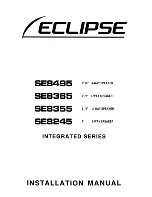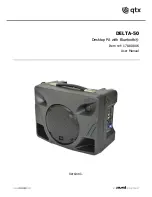
5
Low temperatures and Sound
When speakers are shipped and delivered during the cold months
of the year, it is imperative that they adapt to the temperature of
the living area. Low temperatures have a considerable influence on
the moving parts of a loudspeaker such as diaphragm, voice coil,
bead and spider. The ability of these components to follow rapid
oscillations or to perform large excursions is thus significantly re-
stricted. This is not dangerous, but “frozen” speakers are far from
their acoustic peak.
Hence our tip:
When your new speakers arrive on a cold winter’s
day, just give them a few hours to acclimatise. Your Nubert speak-
ers will thank you with the superior sound quality you have come to
expect from us.
Cloth grille
The cloth grille protects the loudspeaker drivers (for example from
curious children who like to press in tweeter domes) and provides a
visual contrast for those who do not like the technical appearance
of loudspeaker drivers. It is carefully placed against the front of the
speaker and held in place magnetically. Please make sure that the
surface of the baffle is not damaged.
With the cloth grill removed, the loudspeaker sounds somewhat
brighter and clearer - the choice is yours!
EN 12/2019 · E1
2
·
nuPro X-3000
Setup
The nuPro X are high-quality, very neutral active stereo loudspeak-
ers. They impress with an extremely homogeneous, precise, and
“direct” sound reproduction with the finest resolution in the entire
frequency spectrum. However, even “honest loudspeakers” are
exposed to the manifold influences of room acoustics. In order to
achieve the most natural and true-to-life reproduction possible,
please observe the following general installation instructions:
• The rear-facing bass reflex ports should be at least 3 centimetres
away from back- and side walls in order to avoid air flow noise.
Some distance to the back- and side walls also helps prevent an
increase in the bass- and fundamental ranges. If the bass repro-
duction is perceived as being too strong when the speakers are
placed close to a wall, you can raise the lower cut-off frequency of
the speakers, as described on page 8 under
system hp
, and/or ad-
just the bass volume with the bass control as a “countermeasure”.
• When placed on a shelf, the best sound is achieved when the front
edge of the speaker is either flush with the shelf or even protrudes
slightly. This allows the loudspeaker to radiate the sound freely into
the room and helps to avoid voices sounding like coming through
a funnel.
• Within horizontal listening angles up to 30 degrees off the hori-
zontal axis, you will experience no significant change or loss in
sound quality. Only at wider listening angles does the sound lose
its brightness slightly. It is then advisable to point the speakers
towards the listening position.
• The most natural sound is achieved when the tweeters are ap-
proximately at ear level. But even 20 degrees above or below
the tweeter axis, the sound is still homogeneous. If your active
speakers need to be placed lower or higher, they should ideally
be angled so that the tweeters are aimed at the listening position.


































